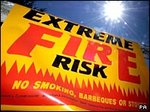England
By Wikipedia
Starting Oct 1st 2006 it was compulsory to complete a fire risk assessment for any premises used for business. This blog guides you about Fire Risk Assessments.

Posted by
Fire Risk Assessments
at
12:54 AM
1 comments
![]()
Labels: Fire Classes, Fire Fighting, Fire Hazard, Fire Rescue Services, Fire Risk, Fire Risk Assessments, UK Public Fire
 A spectacular fire caused heavy damage to the clipper ship Cutty Sark on Monday, adding millions to the cost of restoring one of London's proudest maritime relics. The cause of the blaze was under investigation, but within hours officials responsible for the graceful 19th-century sailing ship said they were determined to carry on with a four-year restoration project.
A spectacular fire caused heavy damage to the clipper ship Cutty Sark on Monday, adding millions to the cost of restoring one of London's proudest maritime relics. The cause of the blaze was under investigation, but within hours officials responsible for the graceful 19th-century sailing ship said they were determined to carry on with a four-year restoration project.
Posted by
Fire Risk Assessments
at
4:47 AM
0
comments
![]()
Labels: Fire Classes, Fire Fighting, Fire Hazard, Fire Risk, Fire Risk Assessments, Fire Safety, Fire Service, Fire Watch, UK Fire
Posted by
Fire Risk Assessments
at
3:38 AM
0
comments
![]()
Labels: Fire Classes, Fire Fighting, Fire Hazard, Fire Risk, Fire Risk Assessments, Fire Safety, Fire Safety Order, Fire Service, Fire Watch, UK Fire